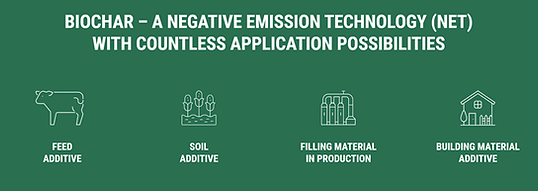01.
The Carbon Removal Project
We are developing Sustainable Carbon Removal projects, that are utilising the most Certified Carbon Removal Technology to produce Certified High Quality Biochar with the consequent creation of significant Carbon Removal Rights CORCS and sellable Renewable Energy.
Carbon Removal is the most drastic method humans have to try to solve the environmental problem.
The Carbon Removal Project is a build-own-operate, multi-location business [one location financially analysed here] which produces high quality biochar at industrial scale using the high-temperature thermochemical conversion of agricultural waste. The multiple-revenue business model monetizes sequestered carbon, creating a climate negative production cycle, and produces biochar and renewable heat. High-spec biochar is in demand and production capacity is growing steadily.
Measurement, Reporting, and Verification (MRV) & Artificial Intelligence
Our competitive advantage is our Advanced Operations System with full monitoring of the whole operations having integrated a sophisticated Measurement, Reporting, and Verification [MRV] & Artificial Intelligence [AI] system [Patent pending]. The system have integrated both worldwide protocols of certifying Carbon Removal Rights [CORCS] [Puro.Earth protocol]. The system traces everything from agreement to source feedstock to the sale of Biochar and C-sink and secures that we will have a clear certification of CORCS [done through international auditors] and at a highest rate [1 tone of biochar 3.2 tones of CORCS]. Everything will be on the Company's Manual so that we can use the best practises and replicate the business model to other regions, countries etc. without any risk.
WHAT IS CARBON REMOVAL /
CARBON CAPTURE
Carbon capture and storage (CCS) or carbon capture and sequestration is the process of capturing carbon dioxide (CO2) before it enters the atmosphere, transporting it, and storing it (carbon sequestration) for centuries or millennia. Usually the CO2 is captured from large point sources, such as a chemical plant or biomass power plant, and then stored in an underground geological formation. The aim is to prevent the release of CO2 from heavy industry with the intent of mitigating the effects of climate change. CO2 has been injected into geological formations for several decades for enhanced oil recovery and after separation from natural gas, but this has been criticised for producing more emissions when the gas or oil is burned.
Carbon capture and utilization (CCU) and CCS are sometimes discussed collectively as carbon capture, utilization, and sequestration (CCUS). This is because CCS is a relatively expensive process yielding a product which is often too cheap. Hence, carbon capture makes economically more sense where the carbon price is high enough, such as in much of Europe, or when combined with a utilization process where the cheap CO2 can be used to produce high-value chemicals to offset the high costs of capture operations.
WHAT IS BIOCHAR
Biochar is a central tool for sustainable climate protection and a material with exceptional properties.
· Biochar has a high carbon content of up to 90 % and binds carbon material reliably, long-term and without negative side effects.
· It is characterized by highly interesting physical and chemical properties and has a positive effect on biochemical processes.
Biochar applications
· Organic Fertilizers/ Agricultural Use / C-Sink [holds water and nutrients 5 times the size, kills parhogens]
· Construction / direct replacement to clinker [5% biochar in cement makes the concrete 20% harder]/ C-Sink
· Livestock Farming [cleans the livestock digestion system
· Steel Industry
· Active Carbon / Water Treatment & Purification Industrial



